David Levine Professorship
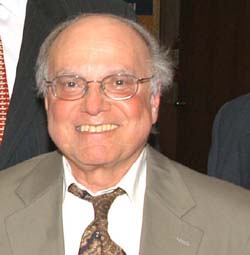
DAVID M. LEVINE, SPH 1969, 1972 (ScD), the former Samsung Professor of Medicine, is director of the Office of Postdoctoral Programs in the Department of Medicine and past director of the Division of Internal Medicine. The physician/scientist’s research focuses on causes and treatment of heart and vascular disease, in particular high blood pressure. In 1990, he was honored with the International Society of Hypertension Award for Outstanding Research Contribution. A member or elected fellow of many professional organizations, Dr. Levine holds a joint appointment at the Bloomberg School of Public Health, where he has headed the Division of Health Education in the Department of Health Policy and Management. He also holds a joint appointment in the School of Nursing and is a core faculty member of the Berman Institute of Bioethics. In 1998, Dr. Levine received The Johns Hopkins University Martin Luther King Jr. Award for Community Service, and in 2005 was honored by the university with a professorship established in his name by contributions from colleagues, family, and friends.
John Eager Howard Chair in Endocrinology and Metabolism
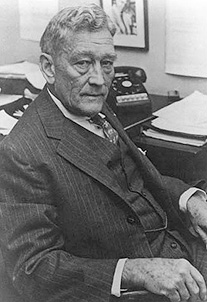 JOHN EAGER HOWARD, Med 1928, was a major figure in the development of the field of endocrinology and metabolism. Among his contributions were the discovery of the association between unilateral renal artery disease and high blood pressure, the development of the Ellsworth-Howard test to determine responsiveness to parathyroid hormone and the introduction of a highly effective approach to the prevention of recurrent kidney stones. A member of the faculty for nearly 60 years, Dr. Howard was the founder and first director of the Division of Endocrinology and Metabolism. In their history of the Hopkins Department of Medicine, Drs. Harvey, McKusick and Stobo wrote: “As much as anyone on the faculty, Dr. Howard was the epitome of sharp clinical acumen coupled with a wealth of scientific knowledge.”
JOHN EAGER HOWARD, Med 1928, was a major figure in the development of the field of endocrinology and metabolism. Among his contributions were the discovery of the association between unilateral renal artery disease and high blood pressure, the development of the Ellsworth-Howard test to determine responsiveness to parathyroid hormone and the introduction of a highly effective approach to the prevention of recurrent kidney stones. A member of the faculty for nearly 60 years, Dr. Howard was the founder and first director of the Division of Endocrinology and Metabolism. In their history of the Hopkins Department of Medicine, Drs. Harvey, McKusick and Stobo wrote: “As much as anyone on the faculty, Dr. Howard was the epitome of sharp clinical acumen coupled with a wealth of scientific knowledge.”
Elizabeth Treide and A. McGehee Harvey Chair in the History of Medicine
 A. McGEHEE “MAC” HARVEY, Med 1934, was physician-in-chief of the hospital and served as mentor to generations of medical students during his more than 40-year professional association with Hopkins. Dr. Harvey, who died in 1998, is credited with bringing the scientific approach in clinical medicine to its full fruition, through the application of techniques and discoveries in the basic sciences to unsolved clinical problems. He chaired the Department of Medicine for 27 years. Stepping down in 1973, he concentrated his research on the history of medicine. From 1982 to 1987, he directed the Alan Mason Chesney Medical Archives. As the School of Medicine’s chief historian and archivist, he wrote nine books on the history of medical and scientific discovery, including a two-volume history of the hospital. Dr. Harvey served as president of the Association of American Physicians and was a fellow of the American Academy of Arts and Sciences and the American Philosophical Society. In 1973, he was the first Hopkins professor to be named a University Distinguished Service Professor.
A. McGEHEE “MAC” HARVEY, Med 1934, was physician-in-chief of the hospital and served as mentor to generations of medical students during his more than 40-year professional association with Hopkins. Dr. Harvey, who died in 1998, is credited with bringing the scientific approach in clinical medicine to its full fruition, through the application of techniques and discoveries in the basic sciences to unsolved clinical problems. He chaired the Department of Medicine for 27 years. Stepping down in 1973, he concentrated his research on the history of medicine. From 1982 to 1987, he directed the Alan Mason Chesney Medical Archives. As the School of Medicine’s chief historian and archivist, he wrote nine books on the history of medical and scientific discovery, including a two-volume history of the hospital. Dr. Harvey served as president of the Association of American Physicians and was a fellow of the American Academy of Arts and Sciences and the American Philosophical Society. In 1973, he was the first Hopkins professor to be named a University Distinguished Service Professor.
This professorship also honors his wife, ELIZABETH TREIDE HARVEY, Med 1943, for her contributions to Hopkins and her steadfast support of her husband. She and her husband married in 1941, at the end of her third year of study at the School of Medicine. That year they left Baltimore for his appointment on the faculty of Vanderbilt School of Medicine, but in 1942, when he joined the Johns Hopkins Unit in the Pacific theater of operations during World War II, Mrs. Harvey returned to complete her MD at Hopkins. She worked for the remainder of the war in the pediatric syphilis clinic with physician Mary Goodwin. She died in 2006 at the age of 90.
Frederick Brancati Professorship
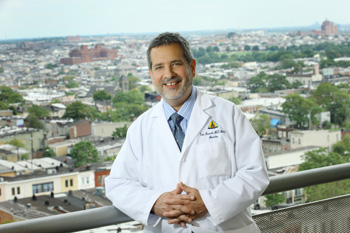 FREDERICK L. BRANCATI, SPH 1992, who died in 2013, was the Samsung Professor of Medicine, Distinguished Service Professor of Medicine, director of the Division of General Internal Medicine, and a member of the active staff of The Johns Hopkins Hospital. Dr. Brancati also held joint appointments in the Department of Oncology and the Johns Hopkins University School of Nursing and was a core faculty member of the Welch Center. He directed the Prevention & Control Core of the NIDDK-funded Hopkins-UMB Diabetes Research & Training Center. An associate director of the Johns Hopkins Clinical Research Network, he served as interim director of the Welch Center for Prevention, Epidemiology, and Clinical Research.
FREDERICK L. BRANCATI, SPH 1992, who died in 2013, was the Samsung Professor of Medicine, Distinguished Service Professor of Medicine, director of the Division of General Internal Medicine, and a member of the active staff of The Johns Hopkins Hospital. Dr. Brancati also held joint appointments in the Department of Oncology and the Johns Hopkins University School of Nursing and was a core faculty member of the Welch Center. He directed the Prevention & Control Core of the NIDDK-funded Hopkins-UMB Diabetes Research & Training Center. An associate director of the Johns Hopkins Clinical Research Network, he served as interim director of the Welch Center for Prevention, Epidemiology, and Clinical Research.
Dr. Brancati was an internationally recognized expert on the epidemiology and prevention of type 2 diabetes and related conditions. He authored more than 230 peer-reviewed scientific papers, with over 20 years of continuous NIH funding, and was a member of the American Society for Clinical Investigation, the American Association of Physicians and the Alpha Omega Alpha and Delta Omega honor societies.
Dr. Brancati was also a highly regarded teacher and mentor, having won numerous teaching and mentoring awards from medical students, graduate students, and postdoctoral fellows at Hopkins, including the Advising, Mentoring & Teaching Recognition Award from the Johns Hopkins Bloomberg School of Public Health (twice), the David M. Levine Mentorship Award from the Department of Medicine, an Aequanimitas Tie from the Osler Medical Housestaff and a Diversity Recognition Award from The Johns Hopkins University for his track record of mentoring women and minorities.
In 2011, Dr. Brancati won the prestigious Kelly West Award for Outstanding Achievement in Epidemiology from the American Diabetes Association and the Chief of the Year Award from the Association of Chiefs of General Internal Medicine. In 2012, he was named a Distinguished Service Professor by The Johns Hopkins University Board of Trustees in recognition of his service to the General Internal Medicine Division and to Johns Hopkins Medicine.
Dr. Brancati received his BA from Harvard University in 1981 and his MD from Columbia University in 1985. After residency training in internal medicine at the University of Pittsburgh where he also served as chief resident, he came to Johns Hopkins in 1989 for a postdoctoral fellowship in the Division of General Internal Medicine and earned a master’s degree in clinical epidemiology from the Johns Hopkins Bloomberg School of Public Health. He joined the Department of Medicine faculty in 1992, was promoted to professor in 2003, and was named director of the General Internal Medicine (GIM) Division in 2004. During his tenure, the GIM Division grew to include 80 full-time faculty, 150 part-time faculty, 17 postdoctoral fellows and more than $30 million per year in NIH and other federal grants (up from $12 million per year in 2004).
He was the founding executive medical director of the Office of Business and Strategic Alliances and of Johns Hopkins Healthcare Solutions. In these roles, Dr. Brancati championed innovative collaborations with industry partners with a focus on population health. One of these collaborations led to an NIH-funded trial of a novel telephone and web-based weight loss program which became the first commercial health care product marketed in connection with the Johns Hopkins name. At his Dean’s Lecture in 2012, Dr. Brancati advocated for a campus-wide focus on population health research and development in collaboration with industry partners.
J. Donald Woodruff Chair in Gynecology and Obstetrics
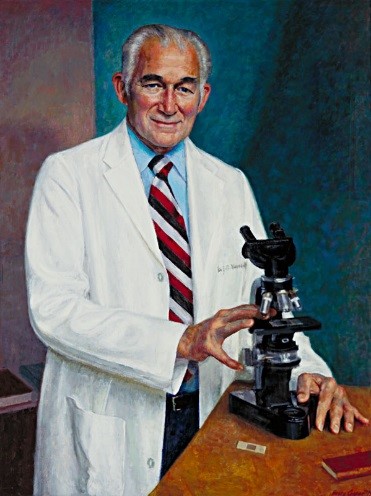 J. DONALD WOODRUFF, MD, was a world-renowned surgeon and professor of gynecologic pathology and gynecology/obstetrics. He earned his bachelor’s degree in 1933 from Dickinson College, where he was a member of Phi Betta Kappa, his medical degree from Johns Hopkins in 1937 and completed his residency in gynecology at Johns Hopkins in 1942.
J. DONALD WOODRUFF, MD, was a world-renowned surgeon and professor of gynecologic pathology and gynecology/obstetrics. He earned his bachelor’s degree in 1933 from Dickinson College, where he was a member of Phi Betta Kappa, his medical degree from Johns Hopkins in 1937 and completed his residency in gynecology at Johns Hopkins in 1942.
He served as chief of urology during World War II with the 56th General Hospital, the first general hospital to land in Normandy after the D-Day invasion. He was discharged at war’s end with the rank of major.
Dr. Woodruff served as president of the Continental Gynecological Society, the Maryland Obstetrical and Gynecological Society, the International Society for the Study of Vulvar Disease, the Johns Hopkins Medical and Surgical Association, and the American Association of Obstetricians and Gynecologists. He was awarded honorary professorships by the University of Tucamen, Argentina; the University of Stellenbosch, South Africa; and the University of Munster, Germany. Dr. Woodruff’s publications include Novak’s Gynecologic and Obstetric Pathology; The Fallopian Tube; chapters in 27 textbooks relating to his specialty; plus 258 original papers.
During his 58-year association with Hopkins, Dr. Woodruff made significant contributions to gynecologic pathology, influenced a generation of residents and provided skillful care to thousands of patients. Widely considered to be the father of gynecologic pathology as a discipline, he pioneered the use of the microscope to advance the diagnosis of diseases. Before his death in 1996 at the age of 84, the university recognized Dr. Woodruff’s many achievements by naming a lecture hall in his honor.
CHAIRHOLDER TO BE NAMED
Russell H. Morgan Professorship in Radiology
 RUSSELL H. MORGAN made significant contributions to radiology by inventing an exposure meter that shut off X-ray equipment the moment film had been properly exposed, reducing unnecessary exposure to radiation. His innovations also improved the precision of X-ray pictures. Dr. Morgan chaired the Department of Radiology and Radiological Science for 25 years, also heading the Division of Radiation Health Sciences in the School of Public Health for a decade. In 1971, he was named dean of the School of Medicine and, two years later, vice president for medicine at Hopkins. Dr. Morgan’s many honors include the 1979 German Roentgen Medal, one of the highest honors in his field. He was the first president of the Association of University Radiologists, a consultant to the surgeon general, and chairman of the National Academy of Sciences Committee on Health Research Programs of the Department of Energy.
RUSSELL H. MORGAN made significant contributions to radiology by inventing an exposure meter that shut off X-ray equipment the moment film had been properly exposed, reducing unnecessary exposure to radiation. His innovations also improved the precision of X-ray pictures. Dr. Morgan chaired the Department of Radiology and Radiological Science for 25 years, also heading the Division of Radiation Health Sciences in the School of Public Health for a decade. In 1971, he was named dean of the School of Medicine and, two years later, vice president for medicine at Hopkins. Dr. Morgan’s many honors include the 1979 German Roentgen Medal, one of the highest honors in his field. He was the first president of the Association of University Radiologists, a consultant to the surgeon general, and chairman of the National Academy of Sciences Committee on Health Research Programs of the Department of Energy.
Martin W. Donner Professorship in Radiology
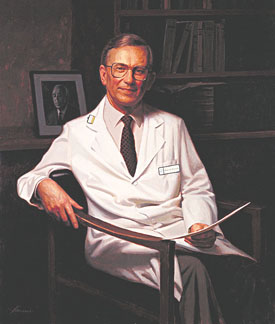 German-born MARTIN W. DONNER arrived at Hopkins in 1957 and for three decades researched the radiological aspects of understanding gastrointestinal functions. As chairman from 1972 to 1987, he led the Department of Radiology through three successive waves of technological advances in the imaging field–ultrasound, computerized tomography, and magnetic resonance imaging. A past president of the Society of Gastrointestinal Radiologists, Dr. Donner was honored with that society’s Canon Medal in 1983. In 1980, he formed a multidisciplinary research and clinical facility at Hopkins, the first center of its kind in the nation, to study and treat swallowing disorders. Over the course of his career Dr. Donner contributed more than 150 articles and book chapters, and went on to become editor of Dysphagia, a journal that focuses on the treatment of these disorders. Dr. Donner, who died in 1992, retired as department director in 1987 to work full time at the swallowing center he had established.
German-born MARTIN W. DONNER arrived at Hopkins in 1957 and for three decades researched the radiological aspects of understanding gastrointestinal functions. As chairman from 1972 to 1987, he led the Department of Radiology through three successive waves of technological advances in the imaging field–ultrasound, computerized tomography, and magnetic resonance imaging. A past president of the Society of Gastrointestinal Radiologists, Dr. Donner was honored with that society’s Canon Medal in 1983. In 1980, he formed a multidisciplinary research and clinical facility at Hopkins, the first center of its kind in the nation, to study and treat swallowing disorders. Over the course of his career Dr. Donner contributed more than 150 articles and book chapters, and went on to become editor of Dysphagia, a journal that focuses on the treatment of these disorders. Dr. Donner, who died in 1992, retired as department director in 1987 to work full time at the swallowing center he had established.
Lawson Wilkins Professorship of Pediatric Endocrinology
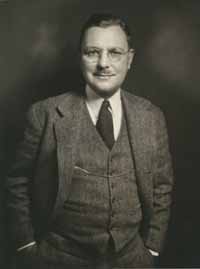 LAWSON WILKINS, Med 1918, founded the first pediatric endocrine clinic in the world at the Harriet Lane Home in Baltimore in 1935. It was during this time that he began to direct his attention to the relationship of endocrinology to human growth. In 1946 he discontinued his private practice of 25 years to devote all of his time to research and teaching pediatric endocrinology. His book, The Diagnosis and Treatment of Endocrine Disorders in Childhood and Adolescence, is internationally accepted as the authoritative text in its field. His investigations of 1940-41 on cholesterol metabolism in hypothyroidism remain classic and valid observations of importance in the study of pediatric endocrine disorders. Dr. Wilkins was a member of numerous medical societies throughout the world and brought to pediatrics a solid foundation for the understanding of endocrine disorders and the rational employment of hormonal therapy. He died in 1963 and is survived by his daughter, Elizabeth McMaster.
LAWSON WILKINS, Med 1918, founded the first pediatric endocrine clinic in the world at the Harriet Lane Home in Baltimore in 1935. It was during this time that he began to direct his attention to the relationship of endocrinology to human growth. In 1946 he discontinued his private practice of 25 years to devote all of his time to research and teaching pediatric endocrinology. His book, The Diagnosis and Treatment of Endocrine Disorders in Childhood and Adolescence, is internationally accepted as the authoritative text in its field. His investigations of 1940-41 on cholesterol metabolism in hypothyroidism remain classic and valid observations of importance in the study of pediatric endocrine disorders. Dr. Wilkins was a member of numerous medical societies throughout the world and brought to pediatrics a solid foundation for the understanding of endocrine disorders and the rational employment of hormonal therapy. He died in 1963 and is survived by his daughter, Elizabeth McMaster.
CHAIRHOLDER TO BE NAMED
George W. Comstock Professor in Epidemiology
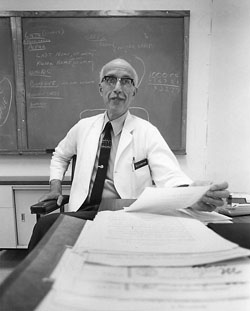 GEORGE W. COMSTOCK, MD, DrPH ’56 (1915-2007), was one of the world’s premier epidemiologists, conducting seminal research on tuberculosis control and treatment and on cancer, heart disease, and lung disease. Dr. Comstock served as a captain in the U.S. Public Health Service for 21 years and taught at The Johns Hopkins University for more than 50 years.
GEORGE W. COMSTOCK, MD, DrPH ’56 (1915-2007), was one of the world’s premier epidemiologists, conducting seminal research on tuberculosis control and treatment and on cancer, heart disease, and lung disease. Dr. Comstock served as a captain in the U.S. Public Health Service for 21 years and taught at The Johns Hopkins University for more than 50 years.
Among his accomplishments, in 1957 he organized one of the first cluster-randomized trials in medicine, a study in the Bethel region of Alaska where tuberculosis was rampant, that demonstrated the effectiveness of the drug isoniazid in preventing TB. Throughout his career, Comstock developed and conducted many innovative community health studies. His work influenced generations of students who now hold top leadership positions in public health agencies and academic organizations throughout the world.
He became professor emeritus at the Bloomberg School of Public Health in 2003, but continued to teach courses on the epidemiologic basis for tuberculosis control until his death in 2007 at the age of 92. He had a thesis to review at his bedside at the end of his life.
“George was a towering figure in the field of epidemiology; those fortunate enough to have been his students knew him as an extraordinary educator who gently led us through the logic of epidemiologic thinking and discovery.” David Celentano, Chair, Department of Epidemiology, Johns Hopkins Bloomberg School of Public Health
George G. Graham Professorship of Infant and Child Nutrition
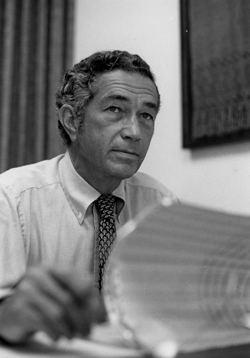 GEORGE G. GRAHAM, MD (1923-2007), was one of the giants of public health and a pioneer in the field of infant and childhood nutrition. A pediatrician by training, he was the first director of the Division of Human Nutrition (now called the Center for Human Nutrition) at the Johns Hopkins School of Public Health. Dr. Graham also held a joint appointment in pediatrics at the School of Medicine. His research focused on prevention and treatment of malnutrition in children and the digestibility and nutritional quality of staple foods. During his tenure at the School of Public Health, which began in 1985 until his retirement in 2001, he was a valued teacher whose masters and doctoral students advanced to prominent positions in academia, industry, and government. He also carried out meticulous clinical and metabolic nutrition research that even today remains highly relevant in meeting modern nutritional challenges.
GEORGE G. GRAHAM, MD (1923-2007), was one of the giants of public health and a pioneer in the field of infant and childhood nutrition. A pediatrician by training, he was the first director of the Division of Human Nutrition (now called the Center for Human Nutrition) at the Johns Hopkins School of Public Health. Dr. Graham also held a joint appointment in pediatrics at the School of Medicine. His research focused on prevention and treatment of malnutrition in children and the digestibility and nutritional quality of staple foods. During his tenure at the School of Public Health, which began in 1985 until his retirement in 2001, he was a valued teacher whose masters and doctoral students advanced to prominent positions in academia, industry, and government. He also carried out meticulous clinical and metabolic nutrition research that even today remains highly relevant in meeting modern nutritional challenges.
David Bodian Professorship
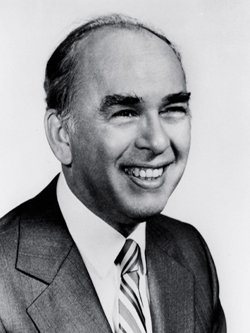 DAVID BODIAN, who held both MD and PhD degrees from the University of Chicago, can be counted as one of the unsung heroes of our era. Supported by a grant honoring President Franklin D. Roosevelt, himself a polio victim, Dr. Bodian entered the Hopkins Department of Anatomy in 1939 as a research fellow. In 1942 he joined the Department of Epidemiology at the Johns Hopkins School of Hygiene and Public Health as an assistant professor and began working in the poliomyelitis laboratory. With colleagues Howard Howe and Isabel Morgan, he helped lay the groundwork for the Salk and Sabin polio vaccines through research into the neuropathology of poliomyelitis. In addition, Dr. Bodian developed a technique to stain nerve fibers and nerve endings (named the Bodian stain) and made major contributions to the knowledge of the basic structure of nerve cells.
DAVID BODIAN, who held both MD and PhD degrees from the University of Chicago, can be counted as one of the unsung heroes of our era. Supported by a grant honoring President Franklin D. Roosevelt, himself a polio victim, Dr. Bodian entered the Hopkins Department of Anatomy in 1939 as a research fellow. In 1942 he joined the Department of Epidemiology at the Johns Hopkins School of Hygiene and Public Health as an assistant professor and began working in the poliomyelitis laboratory. With colleagues Howard Howe and Isabel Morgan, he helped lay the groundwork for the Salk and Sabin polio vaccines through research into the neuropathology of poliomyelitis. In addition, Dr. Bodian developed a technique to stain nerve fibers and nerve endings (named the Bodian stain) and made major contributions to the knowledge of the basic structure of nerve cells.